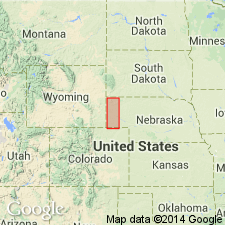
- Usage in publication:
-
- Gering formation
- Modifications:
-
- Original reference
- Dominant lithology:
-
- Sand
- Sandstone
- AAPG geologic province:
-
- Denver basin
Summary:
Pg. 735, 747-755. Gering formation. Coarse sands, soft sandstones, and conglomerate; the sands laminated, massive, cross-bedded, and of light-gray color. Often comprises two or more members, more or less distinctly separated by unconformities. Greatest development is southwest of Gering, [Scotts Bluff County], western Nebraska, where it is 200 feet thick. It is possible upper member of Gering formation is basal portion of overlying Arikaree formation. Rests unconformably on White River group. Age is Miocene.
[GNC remark (ca. 1936, US geologic names lexicon, USGS Bull. 896, p. 814): These deposits are now considered to be local sediments in stream channel and are covered by the broader term Arikaree formation, of which they form basal part.]
Source: US geologic names lexicon (USGS Bull. 896, p. 814).

- Usage in publication:
-
- Gering Formation
- Modifications:
-
- Age modified
- Geochronologic dating
- AAPG geologic province:
-
- Denver basin
Summary:
40Ar/39Ar dates on biotite from a sample from lower white ash (Roundhouse Rock Ash) exposed in basal part of Gering at Roundhouse Rock, Morrill Co, NE (Denver basin), yielded a mean age of 28.59 +/-0.32 Ma. Gering assigned a late Oligocene (Arikareean) age.
Source: GNU records (USGS DDS-6; Denver GNULEX).
For more information, please contact Nancy Stamm, Geologic Names Committee Secretary.
Asterisk (*) indicates published by U.S. Geological Survey authors.
"No current usage" (†) implies that a name has been abandoned or has fallen into disuse. Former usage and, if known, replacement name given in parentheses ( ).
Slash (/) indicates name conflicts with nomenclatural guidelines (CSN, 1933; ACSN, 1961, 1970; NACSN, 1983, 2005, 2021). May be explained within brackets ([ ]).

